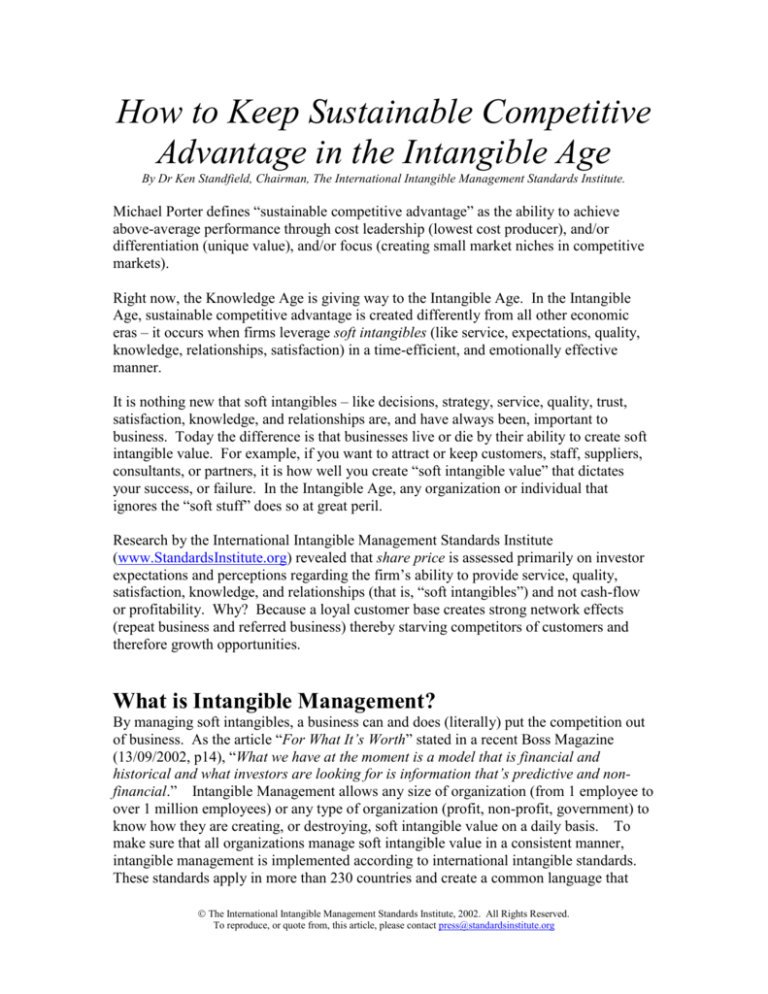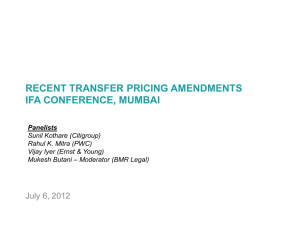
How to Keep Sustainable Competitive
Advantage in the Intangible Age
By Dr Ken Standfield, Chairman, The International Intangible Management Standards Institute.
Michael Porter defines “sustainable competitive advantage” as the ability to achieve
above-average performance through cost leadership (lowest cost producer), and/or
differentiation (unique value), and/or focus (creating small market niches in competitive
markets).
Right now, the Knowledge Age is giving way to the Intangible Age. In the Intangible
Age, sustainable competitive advantage is created differently from all other economic
eras – it occurs when firms leverage soft intangibles (like service, expectations, quality,
knowledge, relationships, satisfaction) in a time-efficient, and emotionally effective
manner.
It is nothing new that soft intangibles – like decisions, strategy, service, quality, trust,
satisfaction, knowledge, and relationships are, and have always been, important to
business. Today the difference is that businesses live or die by their ability to create soft
intangible value. For example, if you want to attract or keep customers, staff, suppliers,
consultants, or partners, it is how well you create “soft intangible value” that dictates
your success, or failure. In the Intangible Age, any organization or individual that
ignores the “soft stuff” does so at great peril.
Research by the International Intangible Management Standards Institute
(www.StandardsInstitute.org) revealed that share price is assessed primarily on investor
expectations and perceptions regarding the firm’s ability to provide service, quality,
satisfaction, knowledge, and relationships (that is, “soft intangibles”) and not cash-flow
or profitability. Why? Because a loyal customer base creates strong network effects
(repeat business and referred business) thereby starving competitors of customers and
therefore growth opportunities.
What is Intangible Management?
By managing soft intangibles, a business can and does (literally) put the competition out
of business. As the article “For What It’s Worth” stated in a recent Boss Magazine
(13/09/2002, p14), “What we have at the moment is a model that is financial and
historical and what investors are looking for is information that’s predictive and nonfinancial.” Intangible Management allows any size of organization (from 1 employee to
over 1 million employees) or any type of organization (profit, non-profit, government) to
know how they are creating, or destroying, soft intangible value on a daily basis. To
make sure that all organizations manage soft intangible value in a consistent manner,
intangible management is implemented according to international intangible standards.
These standards apply in more than 230 countries and create a common language that
The International Intangible Management Standards Institute, 2002. All Rights Reserved.
To reproduce, or quote from, this article, please contact press@standardsinstitute.org
employees, managers, executives, and investors can use to monitor and track the
effectiveness of the business in creating soft intangible value (aka sustainable competitive
advantage).
Competitive Loopholes
Whenever you can provide soft intangible value at a higher level of consistent quality
than your competitors, you have discovered a “competitive loophole”. A competitive
loophole is a competitive “blindspot” that your competition is unaware of. For example,
Gloria Jean’s Gourmet Coffee recently opened a store in the Jam Factory. The
atmosphere of the store is more than comparable to that of Starbucks in Lygon Street.
However, Gloria Jean’s is not managing their intangible value well. Instead of serving
their cakes on washable plates, they serve them on throw away plastic plates. Coffee is
served, not in mugs, but in “takeaway style” paper cups. The end result – an intangible
anomaly is created that leads to customers selecting other options (there are plenty of
coffee shops around the Jam Factory that use real plates and real mugs and serve
excellent cakes and coffee). Intangible anomalies occur when peoples’ perceptions and
expectations are violated. For example, a person may ask “why spend so much money to
fit out this shop with the best furniture and best fittings, and create such a beautiful
atmosphere, if they serve their cakes and coffee in throw-away plastic plates and paper
cups?” Today, it is critical to remember that people buy perceptions and expectations,
not products and services. In other words, people visit shops to purchase experiences,
not to purchase things. Things simply give them experiences. The Intangible Economy
is all about understanding these facts.
The Art of War: 21st Century Style
Sun Tzu, arguably one of the finest military/strategic minds in history stated that battles
were won on the basis of combinations of expected and unexpected tactics. Unexpected
tactics are those that are not easily replicated, copied, or even known by your
competitors. Not surprisingly, unexpected competitive tactics rely almost exclusively on
managing soft intangibles effectively and efficiently. For example, customer service is
an unexpected tactic as so few organizations actually provide quality customer service
these days. By implementing international intangible standards, the corporation is able
to visibly manage its competitive advantage and therefore stand out from the crowd.
High staff knowledge is an unexpected tactic as so few employees seem to know much
about what they sell. Emotionally intelligent interactions with customers and staff are
also an unexpected tactic as such interactions are so rare. Time effective service is also
an unexpected tactic, as so few businesses seem to value customer time (despite time
being such a valuable asset).
The International Intangible Management Standards Institute, 2002. All Rights Reserved.
To reproduce, or quote from, this article, please contact press@standardsinstitute.org
The Key Lesson: Soft Creates Hard
One of the most powerful lessons you can learn about soft intangibles is that soft creates
hard. That is, soft intangibles (decisions, knowledge, service, emotions, etc) must be first
leveraged in order for financial transactions to occur. If you have not purchased
something you wanted due to poor customer service, then you personally understand this
rule. If the quality of soft intangibles is too low, then you will not purchase.
In short, the quality of soft intangibles is like a magnet that either attracts customers to a
product/service, or repels them from it.
In summary: Manage intangibles correctly and success is yours. Manage them poorly
and failure will follow.
New Management Skills Required
The recently published book “Intangible Management: Tools for Solving the Accounting
and Management Crisis” by Ken Standfield provides the essential foundations you
require in order to understand soft intangibles. It does this by exploring international
intangible standards thereby establishing the common language required to manage soft
intangibles across the globe.
As a manager in the Intangible Age, you need to understand that you now have three
types of resources you can manage: (1) financial resources, (2) hard intangibles – such
as intellectual property which can be owned, and (3) soft intangibles – such as
knowledge, relationships, emotions, satisfaction, service, trust, decisions which cannot be
owned. Out of all of these resources it is the management of soft intangibles that creates
sustainable competitive advantage, generates financial performance, and places pressure
on your competitors.
By implementing intangible management practices organizations become more
transparent, thereby allowing organizations to win back the trust of their employees and
the respect of their customers and investors. By adhering to international intangible
standards organizations can start fresh and present a consistent image of corporate, moral,
and ethical responsibility (soft intangibles).
The International Intangible Management Standards Institute, the developers of
Intangible Management and International Intangible Standards holds regular free
introductory briefings on intangible management and also conducts worldwide
certification and education. For more information, please email
briefings@StandardsInstitute.org
Ken Standfield is the Chairman of the International Intangible Management Standards
Institute and presents national and international workshops, and certification classes in
Intangible Management and International Intangible Standards. Free membership to the
Institute is available by visiting http://www.StandardsInstitute.org
The International Intangible Management Standards Institute, 2002. All Rights Reserved.
To reproduce, or quote from, this article, please contact press@standardsinstitute.org










